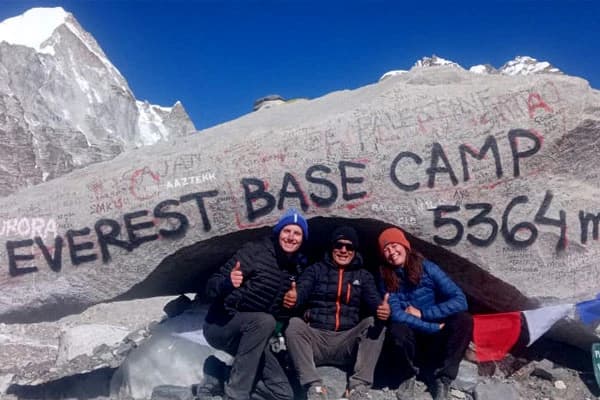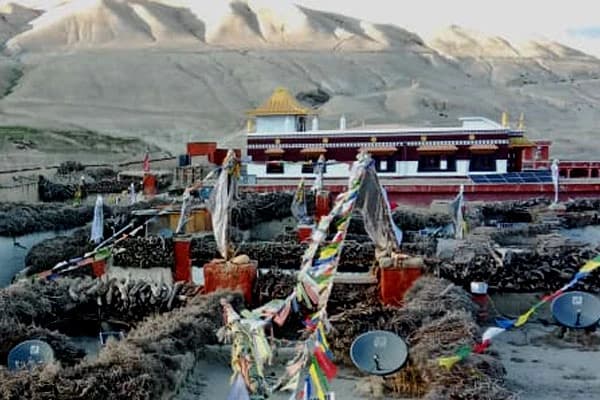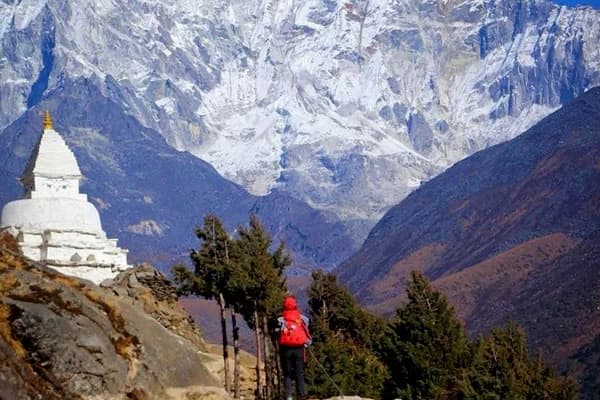Why choose this trek to Everest High Passes - 3 Everest Pinnacles?
If you are seeking an authentic mountainous adventure, then this trek offers you more than traditional Everest views. This unique trek provides an off-the-beaten-path experience by leading you across three high mountain passes while uncovering hidden natural gems that ordinary travelers fail to discover.
Off-beaten adventure
The Everest 3 Passes Trek directs you toward offbeat routes because most travelers choose traditional main trails. The usual crowd of the Everest Base Camp route does not exist here, and this path guides you toward serene valleys with observation points as you explore distant areas starting from Gokyo Valley and continuing to Chukhung Valley.

Apart from showing you hidden sights such as the blue Gokyo Lakes, the trail guides you through small Sherpa villages and quiet passes that often have only you as the sole hiker. The secluded sites enable you to build deeper bonds with the mountains while granting you enough time to appreciate the natural landscape firsthand. It's just you and the amazing natural vistas!
Traditional Route
This trek leads visitors through trails that diverge from the main crowds found on the Everest Base Camp (EBC) or Annapurna Base Camp Trek route, as the traditional circuit routes receive fewer trekkers, which allows you to have a genuine trekking experience. Flying to Lukla, you start your trek on the standard Everest trail, although your path soon moves into less-traveled regions where people lead their traditional lifestyles.
The path delivers better opportunities to experience traditional Sherpa settlements, which most trekking groups typically avoid, like the barely touched villages of Thame, Lungden, and Chukhung, where residents continue traditional farming activities and yak herding while practicing their Buddhist customs.
Most tourists traveling to the Everest region opt for the main path since it provides a simpler and faster journey and because of the demanding nature of the route, locals preserve their traditional village characteristics. The journey allows you to connect with individuals who truly represent their culture by observing genuine traditions and understanding how people live harmoniously with the mountain environment.
So, as you follow this traditional route, you can have a more authentic experience of the Himalayan lifestyle and untouched beauty.
Crossing Three High Passes Over 5000 meters
Who would have thought that there exists an adventure that reaches high passes?? All over 5000 meters! The main highlight of this trek involves overcoming three high and challenging mountain passes reaching heights of Renjo La (5,360m), Cho La (5,420m), and Kongma La (5,535m). These passes elevate you above many mountain peaks! The climb requires careful walking on rugged terrain, which might include snow sections alongside steep ascents that challenge your physical capacity.

From each pass summit, you obtain stunning vistas that consist of limitless mountain scenery and the planet's tallest peaks encircling you. Viewers standing on these passes get distinct mountain views since Renjo La reveals Everest and Cho La displays the Gokyo and Khumbu valleys, and Kongma La presents both Makalu and Khumbu Glacier.
The three mountain passes provide distinct parts that test your abilities while giving spectacular vistas, which will create everlasting memories. Going through these three passes beyond 5000 meters provides a true sense of personal accomplishment.
Summary of Three Passes: Renjo La, Cho La, and Kongma La Pass
Renjo La Pass
Everest 3 Pass Trekking starts with your first pass crossing point at Renjo La, and the climb starts from the beautiful Gokyo village beside the turquoise Gokyo Lakes. A rocky climb takes you to the steep stone staircases at the end of the climb, which guide you across. From Renjo La, you gain access to one of the Himalayas' top-tier perspectives, which includes the remarkable mountaintop formation of Everest, Lhotse, Makalu and Cho Oyu and the sparkling Gokyo Lakes shimmering like precious blue jewels before descending to the peaceful Thame Valley. It takes approximately 6-7 hours to cross this pass according to your walking speed and weather conditions. What makes this pass popular among travelers is the breathtaking mountain view from its peak. Even favourite!
Cho La Pass
The trail connecting the Gokyo Valley to the main Everest Base Camp route passes through Cho La, leading from Dzongla and Thangnak through a stone valley to reach an elevation where you must navigate past enormous rocks. It becomes the most challenging to cross the tiny glacier at the summit because it turns very slippery during the morning hours. Most hikers need between 7-8 hours to walk through this pass, usually starting their journey in the early morning to ensure safety.

At the top of Cho La pass, prayer flags welcome you with breathtaking mountain panorama views, including Ama Dablam. The downward trail starts steep before transitioning into a part filled with loose rocks, then comes easier sections when descending toward Thangnak and ultimately reaching Lobuche.
Kongma La Pass
Kongma La stands both as the highest and last pass among 3 everest passes.. Most hikers begin their journey either from Lobuche or Chukhung, while the day starts before sunrise to tackle the length of the route. The path ascends continuously through empty landscapes which contain mainly rocks, with the view of ice formations as you walk beside the Khumbu Glacier and hear its loud creaking sounds as it moves.
At the top, where prayer flags create colorful decoration, you will see Island Peak, Makalu and Ama Dablam peaks. Moving down becomes difficult because the trail consists of steep terrain with loose rocks that lead to Chukhung Valley. Kongma La becomes the most challenging pass for trekkers due to its elevation and an extended 8-9 hours single-day walking route.
See our Guided Three Passes Trek package for a hassle-free journey!
Comparison With Other Everest Region Treks
Among all the trekking options in the Everest region, this trek to 3 passes stands as the most demanding and extensive adventure. The 18-20 day itinerary leads hikers through a distinct circular route that spans across Renjo La (5,360m) and Cho La (5,420m), and Kongma La (5,535m). During this journey through Everest, you will discover Gokyo Lakes and Everest Base Camp along with Kala Patthar viewpoints and numerous traditional villages. This demanding trek extends over many days across a wide range of landscapes before granting you its most expansive viewing possibilities. This trek suits pro hikers who want to experience all the prime spots in the Everest region while bypassing popular trails.
The Gokyo Lake Trek presents a shorter adventure focusing on the mystical blue lakes situated within the Gokyo Valley. The 12 to 14-day hiking adventure lets you experience mountain vistas without encountering heavy crowds. Climbing up Gokyo Ri to 5,357 meters will reward you with spectacular views pointing at Everest, Lhotse, Makalu, and Cho Oyu mountains. This trek fits people looking for quiet natural landscapes aside from Everest Base Camp, but not requiring access to Base Camp itself.
Among all trekking routes in Nepal, the Classic Everest Base Camp Trek stands as the most favored option by tourists all over the world and takes 12 to 14 days to access Mount Everest Base Camp. The Khumbu Valley reveals its famous path to Namche Bazaar along with Tengboche, as it leads hikers to the Sagarmatha National Park. During your journey, you can reach the summit point of Kala Patthar for perfect Mt. Everest views before proceeding to Base Camp, which serves as the starting point for summit attempts by mountaineers. Many guest houses have established this trail so it remains comfortable despite heavy foot traffic during peak months. The trek features an up-and-back journey on one path instead of a round journey and therefore works well for first-time Nepal trekkers.
The Everest Base Camp Trek Via Gokyo Lake merges two famous trails into a complete 16-18 day journey as it starts with a visit to the tranquil Gokyo Lakes, followed by a difficult crossing of Cho La Pass to access the main Everest Base Camp trail. By combining two routes, you get the peaceful ambiance of Gokyo and the exciting experience of reaching Everest Base Camp. This journey represents a challenge above a regular Base Camp Trek because of its high pass, although it remains easier than all three passes combined.
The Gokyo Lake and Renjo La Pass Trek takes between 14 to 16 days to complete its route through the western section of the Everest region. During this trek, you will see the stunning Gokyo Lakes while walking across Renjo La Pass, which is famous for it stunning views of Everest and other peaks.
From crossing the pass, you will continue to the sparsely visited Thame Valley. This trek provides high mountain thrills and minimal crowds and delivers a satisfying adventure between basic treks and the challenging three-pass experience. Also, some people love to do only the EBC Gokyo Cho La Pass Trek that visits the base camp, six Gokyo lakes, and one of the high passes of Cho La- 5173 meters.
Highlights and Acclimatization along the Route
Every trekker who takes on this trek creates life-changing memories because of its spectacular views. Two designated rest days are scheduled at Namche Bazaar and Gokyo for participants to spend time at the same altitude level. The extra days allow you to perform brief elevation hikes before returning back for rest. The rest days at Namche Bazaar and Gokyo allow you to experience picturesque villages while appreciating stunning scenery while your body adapts to future high-altitude pass journeys.
Iconic Viewpoints
The highest point of the entire trek reaches 5,545 meters in elevation at Kala Patthar, where you can view Mount Everest with perfect clarity. Standing opposite Everest, this dark rocky ridge provides unobstructed sight of the entire mountain from its base to its peak. Traversing from Gorak Shep to Kala Patthar requires about 2 hours of climbing through a steep terrain that takes you to the top to see Nuptse, Lhotse and Everest alongside the Khumbu Glacier underneath.
You can enjoy a breathtaking mountain panorama from Gokyo Ri (5,357m) that shows Everest alongside Lhotse, Makalu and Cho Oyu among the four highest peaks in the world along with a magnificent view of the blue Gokyo lakes and Ngozumpa Glacier. Most hikers say Gokyo Ri gives better mountain view panoramas than the vista from Kala Patthar. But hey, you can be the judge later!
Everest Base Camp(EBC) and Gokyo Lakes
Mount Everest Base Camp sits at 5,364m just below the crown of Mount Everest, which stands as Earth's tallest mountain. From this viewpoint, you cannot catch a peek of Everest's summit but you can witness the threatening Khumbu Icefall where climbers commence their ascent. During climbing season, the actual camp rests on the Khumbu Glacier with colorful tents and prayer flags. The experience of walking on this glacier creates an otherworldly sensation because it shows ice formations alongside glacier dust-covered rocks.
The Gokyo Lakes consist of five high-altitude turquoise lakes that exist at an elevation of over 4,700m, thus placing them among the highest freshwater lakes in the world. All in one location! The sacred lakes are encircled by snowy peaks which create mirror-like reflections across their still surface during calm weather. And you'll be amazed to see ducks swimming around. Yep, even above 4,700 meters! . A stroll through these lakes provides you with quiet times away from active trekking paths.
Village Exploration
During the trek, you will explore numerous Sherpa settlements that extend across the Everest region, where each village shows how people with many generations have adjusted to mountain living. The villages provide accommodation for resting with options to learn about local culture alongside opportunities to taste traditional foods while encountering friendly mountain inhabitants.
Namche Bazaar functions as a top Sherpa settlement throughout the region, and it provides crucial acclimation opportunities, which is nestled in the mountainside. Do you know that it is shaped like a horseshoe? Yes, and features remarkable buildings where people can enjoy freshly baked goods at cafes, followed by a renowned Saturday market. You can experience Sherpa culture at the museum and gaze at Everest from the Everest View Hotel or unwind with hot chocolate.
The beautiful farming village of Dingboche has its land divided into sections for potato cultivation and yak grazing pastures by stone barriers. From its valley location, the village delivers spectacular views of Ama Dablam mountain and offers the chance to climb Nangkartshang Peak for stunning mountain views.
The traditional village of Thame lies at a distance from the main trail of EBC and it is the birthplace for several Sherpa mountaineers, including Tenzing Norgay, who first achieved Everest's summit with Edmund Hillary. You can visit the historic monastery situated above the town that faces the ancient village and watch the stunning views of the mountains.
The small town of Gokyo sits next to the third Gokyo Lake and offers a peaceful atmosphere while standing at its high-altitude location. From here, you can climb Gokyo Ri while also visiting both the upper lakes and massive Ngozumpa Glacier.
How to reach the Everest 3 High Passes?
The journey to Three Passes begins in busy Kathmandu, and the next stop takes you on a brief flight directly to Lukla, which serves as the entrance point to explore the Everest region.
Your journey leads from Namche Bazaar west toward Thame and Lungden until you reach Renjo La, which serves as your first high pass. You arrive at Gokyo Lakes, which presents the opportunity to ascend Gokyo Ri to enjoy panoramic views of the landscape. Dzongla stands as your next destination after crossing Cho La Pass, and then you progress through Lobuche until you reach Gorakshep to finally arrive at Everest Base Camp. Your journey continues after witnessing the dawn from Kala Patthar as you advance to Kongma La, which stands as the highest of all passes, before returning through Dingboche, Tengboche, and ending at Lukla for your return flight to Kathmandu.
Note: Our package follows well well-crafted itinerary with the best acclimatization days.
Best Time to Trek the Three Passes
Spring (March to May) and autumn (September to November) stand out as the prime times for trekking the Three Passes route since weather conditions remain consistent and visibility reaches its peak. The main advantage? You can expect safe trails since the area experiences no rainfall and stays free from heavy snow or high humidity conditions. Springtime brings rising temperatures and beautiful rhododendron flowers to create white and red and pink color displays across the lower region.
Autumn delivers stable weather conditions which allow you to witness spectacular mountain views during clear days with bright blue skies. You can also enjoy the local festivals like Dasain and Tihar that add a unique cultural charm to your journey. The daytime temperatures allow for comfortable walking conditions but temperatures become cold during nighttime at high altitudes.
Passes remain covered in snow throughout the wintertime (December to February) and are often dangerous due to freezing temperatures that might block passage.. The summer months (June to August) bring heavy monsoon rains and obscured mountain views due to clouds while trails become muddy and slippery.
Physical Preparation and Acclimatization Tips: Please Consider
- Initiate your training routine two to three months before the trek by stair-climbing exercises, hiking and walking activities to develop endurance.
- You should do cardio activities including running, swimming or cycling three or four times weekly to build both your lungs and heart strength needed for high altitude conditions.
- The challenging uphill terrain and steep passes require you to include leg strength exercises like squats, lunges and step-ups into your training.
- Trekking with a weighted backpack matching your final pack that carries the same weight helps your body adapt to the expected weight during the hike.
- During the trek, always maintain a steady walking speed and do not try to rush if you feel tired.
- Your daily water consumption should reach at least 3-4 liters because this hydration level protects you from altitude sickness.
- Rest days require short climbs toward higher elevations but sleep at locations with lower heights as part of the "climb high, sleep low" method.
- Acclimatization days should never be skipped because your body needs each scheduled day to adapt correctly despite feeling fine.
- Understand how to identify symptoms of altitude sickness by paying attention to headaches, feeling dizzy, losing appetite, nausea and sleeping problems and breathing issues.
- When experiencing symptoms, inform your guide right away and prepare for descent if your condition worsens.
Permits, Logistics, And Transportation: See What's Included
The two essential permits for the Everest 3 Passes Trek consist of the Sagarmatha National Park Entry Permit (3,000 Nepali Rupees/about $23) and the Khumbu Pasang Lhamu Rural Municipality Entrance Fee (2,000 Nepali Rupees/about $15). Trekking packages often include the price for permits among their expenses. The permits require both passport photos and a copy of your passport.
The trek to Three Passes begins with a brief 30-minute flight between Kathmandu and Lukla airport which provides exceptional views of the mountain peaks. The price of flying to Lukla from Kathmandu is part of standard trekking packages together with the cost of the Lukla to Kathmandu flight. The trek flights operate based on weather conditions thereby causing occasional delays which require a flexible itinerary.
The trekking packages from an authorized trekking agency like Destination Himalaya Treks provide you with tea house lodging which run throughout the trekking route with simple amenities and shared dining areas. The travel packages provide all meals which include breakfast and dinner at the tea houses and lunch at eating spots along the trail. The demanding journey requires guide and porter services which all packages provide. A guide provides direction and arranges logistics while watching your health and giving you insights about the destination. The porters will handle most of your equipment so you can walk with just a minimal day pack loaded with water bottles, snacks and your personal belongings.
Custom Itineraries Or Group Discounts for 2025 and 2026
Trekking agencies will adjust their standard itineraries according to your preferences so simply request changes when booking your travel to get either additional rest days or to include added destination stops or to shorten the trekking period. The companies prepare personalized routes based on your individual needs like time and budget. When traveling with friends or family members, you can also get a special discount offer. Most trekking companies provide better rates to groups consisting of four individuals or more. The number of participants in your group determines how large the discount will be. A limited number of companies provide exclusive offers and reduced rates for off-season trek too. Most trekking companies expect queries about price modifications or better offers and they will gladly assist you to create your ideal trek experience.
Contact us at Destination Himalaya Treks and Expedition for a custom itinerary and group discounts for the best price!
How to book this expedition?
You can easily arrange your 3 Passes Trek booking. Choose spring or fall seasons for your trekkers because they provide better weather conditions, and review multiple trekking companies online to study their reviews from trekking clients. Review their plans to confirm the inclusion of permits, both Lukla flights, meals, and accommodation in their quoted price. After selecting your preferred company, you should complete their booking form or contact them by email. They will need some personal details and a deposit equal to 20% of the total expense for securing your trekking slot, and allow you to finalize your payments upon your arrival in Nepal. The booking process for the trek starts at least 2-3 months ahead to secure your spot, particularly when you choose peak seasons.
You can email us at info(a)destinationhimalayatreks.com for the booking confirmation, or you can phone or message us on WhatsApp at +977 9851016814 with any questions. To manage everything, we just deduct 20% of the entire fee; the remaining sum may be paid after you get to Kathmandu. We are also open for last-minute booking, so do not hesitate to contact us as we are here to assist you at all times!







